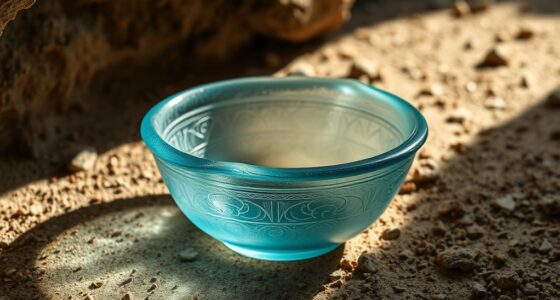Viking DNA shows they weren’t just from Scandinavia but had diverse roots across Europe, Asia, and North Africa. Their genetic makeup reveals extensive mixing due to trade, exploration, and interactions along maritime routes. Vikings often integrated with local populations, making their ancestry more complex than previously thought. This genetic diversity highlights their role as traders and explorers rather than only warriors. If you look deeper, you’ll uncover how their widespread connections shaped their remarkable history.
Key Takeaways
- Viking DNA shows extensive admixture from Europe, Asia, and North Africa, indicating diverse origins beyond traditional Scandinavian roots.
- Genetic evidence reveals significant gene flow from the British Isles and Eastern Europe through trade and interactions.
- Maritime trade routes facilitated long-term cultural exchanges, resulting in widespread genetic mixing among Viking populations.
- Viking ancestry includes influences from the Middle East and Eurasia, highlighting their participation in broad migration networks.
- DNA findings challenge the view of Vikings as solely homogeneous Scandinavians, emphasizing their role as interconnected explorers and traders.

Recent genetic research has upended long-held assumptions about Viking origins, revealing a more complex and diverse picture of their ancestry across Europe. Instead of originating from a single homeland, Vikings show evidence of extensive genetic admixture, reflecting a history shaped by migrations, conquests, and interactions with various populations. When you look at their DNA, it’s clear that Vikings weren’t just Scandinavian warriors; they were a melting pot of different ancestries, with gene flow coming from across Europe, Asia, and even North Africa. This diversity is largely due to their active participation in maritime trade routes that spanned the North Atlantic, Baltic Sea, and beyond. These routes didn’t just facilitate the exchange of goods but also enabled the movement of people, ideas, and genetic material. As Vikings traveled, they encountered and intertwined with local populations, leaving traces of their interactions in their DNA. Additionally, the maritime trade networks they utilized played a crucial role in fostering these diverse genetic exchanges. Through the study of ancient and modern DNA samples, scientists have uncovered that Viking genetic admixture is more widespread and varied than previously thought. Some Viking communities contain significant genetic input from the British Isles, Eastern Europe, and even distant regions like the Middle East. This suggests that Viking expansion wasn’t merely about raids and conquest but also involved sustained contact and integration with diverse peoples along their routes. Maritime trade routes played a pivotal role in this process, acting as arteries that connected distant lands and cultures. As Vikings traded goods like silver, furs, and spices, they also exchanged genetic material, creating a web of interconnected populations. These interactions contributed to the diversity seen in Viking DNA, showcasing a complex tapestry of ancestries rather than a homogeneous Scandinavian lineage. The evidence of genetic admixture underscores how Vikings were more than just fierce warriors—they were traders, explorers, and integrators. Their presence along various maritime routes meant they constantly encountered new peoples, which influenced their genetic makeup over generations. This ongoing exchange resulted in a lineage that reflects a broad European and even Eurasian influence. So, when you examine Viking DNA, you’re not just seeing the legacy of Scandinavian origins but also the fingerprints of a dynamic network of peoples linked through trade, migration, and cultural exchange. This new understanding challenges traditional narratives, revealing Vikings as adaptive and interconnected players on the European stage, shaped by centuries of diverse interactions across vast maritime networks.
Frequently Asked Questions
Can Viking DNA Be Used to Predict Future Health Risks?
You might wonder if Viking DNA can predict future health risks. While genetic health insights can identify disease predispositions, they aren’t definitive predictors. Your DNA provides clues about potential vulnerabilities, but many factors influence health. Viking DNA can contribute to disease prediction, yet it’s just one piece of the puzzle. Regular health screenings and lifestyle choices remain essential for managing your health, regardless of your ancestral genetic makeup.
How Accurate Are Viking DNA Analysis Methods Today?
Imagine peeling back the layers of history—today’s genetic testing methods are quite precise, like a detective unraveling clues. When you explore Viking DNA analysis, the ancestry accuracy is high, though not perfect. These methods use advanced sequencing technology to identify genetic markers, but some genetic variation can still challenge complete certainty. Overall, you can trust that current Viking DNA analysis gives a reliable glimpse into your ancestral roots, with room for ongoing refinement.
Do Viking DNA Findings Affect Modern Cultural Identities?
Your understanding of cultural identity and heritage preservation can be deeply influenced by Viking DNA findings. When you learn about the diverse origins of Viking ancestors, it may inspire you to embrace a broader sense of heritage and challenge traditional stereotypes. These discoveries encourage you to see cultural identity as fluid and interconnected, fostering pride in your unique history while promoting respect for the rich tapestry of European heritage.
Are There Ethical Concerns in Studying Viking Genetic Heritage?
You should consider that studying Viking genetic heritage raises ethical concerns, especially regarding genetic privacy and cultural appropriation. You might unintentionally reveal individuals’ genetic information or reinforce stereotypes. It’s important to handle data responsibly, respecting personal privacy, and avoid misusing cultural symbols. By being mindful, you help ensure that research honors heritage without causing harm or infringing on personal rights, fostering respectful understanding of Viking history.
How Does Viking DNA Compare to That of Other Ancient Populations?
You’ll find that Viking DNA shows remarkable genetic diversity, reflecting complex migration patterns across Europe. Compared to other ancient populations, Vikings often have a mix of Scandinavian and diverse European genes, indicating extensive movement and interbreeding. This genetic blending highlights their wide-reaching influence and migration routes. Studying these patterns helps you understand how populations interacted and evolved, giving you a clearer picture of Europe’s ancient and dynamic history.
Conclusion
So, next time you think of Vikings as just fierce warriors from Scandinavia, remember their unexpected roots across Europe. Their DNA shows a blend of influences, proving they’re more than just raiders—they’re a diverse mosaic of cultures. Isn’t it fascinating how history and genetics reveal stories we never knew? By uncovering these surprising origins, you see how interconnected our past truly is. Who knows what other secrets lie hidden in our DNA, waiting to be uncovered?









